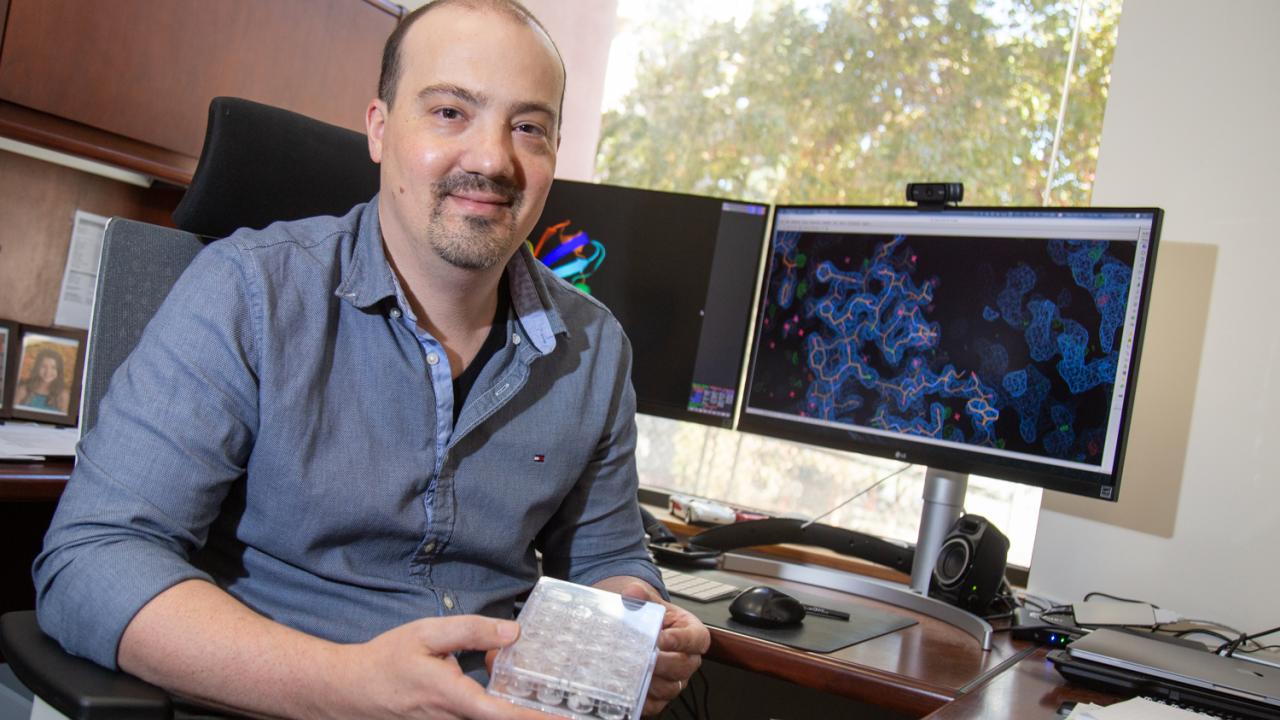
Nature Paper Unravels Dynamics of Plant Hormone Interactions at Atomic Resolutions
Quick Summary
- The study adds structural definition to the plant strigolactone signaling process
- Strigolactones are hormones integral to plant growth, involved in nutrient uptake and shoot branch growth
- The study reveals how these hormones interact with the cell's recycling system at the atomic level
In 1880, Charles Darwin and his son Francis explored plant architectures in “The Power of Movement in Plants.” One of their most famous experiments was based on the concept that plants bend towards the light. When they cut the tips of their experimental plants’ shoots, Darwin and his son found the plants no longer responded to light. “These results,” Darwin wrote, “seem to imply the presence of some matter in the upper part which is acted on by light, and which transmits its effects to the lower part.”
While Darwin didn’t know the name of that “matter,” scientists later determined that Darwin and his son disrupted the transmission of a hormone called auxin, which is integral to plant growth and behavior.
“Plants are sessile,” said Assistant Professor Nitzan Shabek, Department of Plant Biology. “They’re stuck in the ground and in order to cope with the ever-changing environment, they use a set of natural biological molecules.”
Since his postdoctoral years at the University of Washington, Shabek, a biochemist and structural biologist, has studied a group of plant hormones called strigolactones, produced in the roots. Strigolactones are involved in many aspects of plant growth and are necessary for nutrient uptake, root elongation, leaf aging and shoot branch growth.
They are also the signal that the parasitic plant family Striga, a devastating pest of African sorghum crops, uses to find and attack plants.
Though many of the genes and proteins associated with strigolactone signaling have been identified, how these biomolecules interact with one another and how exactly plant cells sense and signal with these hormones has remained largely elusive. But in a new study appearing in Nature, Shabek and his colleagues at the University of Washington and the University of Cambridge add structural definition to this biological process.
“In this work, by combining various approaches in biochemistry, structural and plant biology, we uncover a novel mechanism in the strigolactone signaling pathway,” Shabek said. “From the atomic level all the way to the function in plant cells, we showed that protein degradation is timely coupled to hormone metabolism, and that this process is regulated by enzyme dynamics.”

Quality control at the molecular level
In all life that contains a cell nucleus, including plants, the ubiquitin-proteasome system ensures quality control of the molecules within the cell. Damaged or no longer useful proteins are targeted by this system for removal.
“Countless cellular process such as the cell cycle cannot advance if certain proteins don’t degrade in time,” said Shabek. “So there has to be tightly controlled cellular regulation of proteins levels based on their function.”
Proteins are targeted for destruction after being linked to a smaller protein called ubiquitin. Ubiquitin acts like a molecular flag, allowing the proteasome, a cellular machine akin to a paper shredder, to recognize a damaged protein and shred it to pieces.
Using X-ray crystallography, a technique that allows scientists to view molecules at the atomic level, Shabek and colleagues revealed a detailed biochemical path of how strigolactone interacts with proteins and how it’s regulated by the ubiquitin-proteasome system. They found that a certain element of an ubiquitin ligase protein known as D3/MAX2 exhibited multiple functional formations. D3/MAX2 is a crucial enzyme in the regulation of the strigolactone response.
“Once we revealed the crystal structure of rice (Oryza) D3, we were able to capture different conformational states. In other words, this is a dynamic protein,” said Shabek. “Usually in structural biology when you have different structures of the same protein, you want to ask if that structure is biologically relevant, and what is the nature of its function?”
Function in formation
Shabek and colleagues found that when D3 protein exhibits a certain configuration, it can bind with the strigolactone receptor D14. When this receptor senses strigolactone, it cuts the hormone, thus disrupting its signal, a process known as hydrolysis.
“We found it peculiar that a hormone receptor, D14, was destroying its signal, strigolactone,” said Shabek.
The researchers found that in its open configuration, D3 prevents D14 from quickly destroying strigolactone, allowing enough time for the hormone to interact with a key transcriptional repressor called D53, which is subsequently degraded by the proteasome. When there are high levels of strigolatone, more D53 proteins are removed, allowing the plant to reactivate strigolactone responsive genes in order to regulate functions like shoot branch growth and root elongation.
“In this work, we provide yet another layer of understanding for how the strigolactone signaling pathway is being regulated,” said Shabek.
Harnessing plant hormones
When a plant requires more nutrients from the soil, strigolactones are exuded from the plant’s roots to signal fungi to form a network of tubes that absorb more nutrients from the soil. This ancient symbiosis has been exploited by a family of parasitic plants called Striga that grow nearby and penetrate the host plant’s roots, sucking all the nutrients and destroying the plant. This is a devastating agricultural problem.
Shabek hopes that better understanding strigolactone signals at the atomic level will help farmers fight parasitic plants. He also sees potential for the research to be used beyond plants.
“The ubiquitin system is in the center of so many cellular processes and therefore has been implied in countless pathophysiological conditions and diseases such as cancer and neurodegenerative disorders,” he added. “Deciphering how certain small-molecule regulate the ubiquitin system components is the key to drug discovery.”
The study was supported by the Howard Hughes Medical Institute, the Gatsby Charitable Foundation and the European Research Council.

